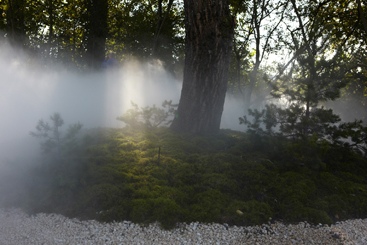
Born in 1933 in Sapporo (JP). Lives and works in Tokyo (JP).

2011
In Situ installation
Mist sculpture and japanese garden
Landscape architect : Masatsugu Matsudaira
Year of Purchase: 2010
As a part of the Osaka Universal Exhibition in 1970, Fujiko Nakaya created Pepsi Pavilion—Fog Sculpture #47773_. It was the first of several hundred “fog sculptures” to be produced by the Japanese artist: in natural environments (Foggy Wake in a Desert: An Ecosphere—Fog Sculpture #94925_, in 1983, in Australia); in architectural or museum public spaces (F.O.G.—Fog Sculpture #08025, in 1998, at the Guggenheim Museum in Bilbao); or in scenic spaces. Well-known collaborations include her work with choreographers Trisha Brown, in 1980, for Opal Loop—Fog Installation #72503 City, and in 2013 with Gisèle Vienne, for This is How You Will Disappear (The Broken Version).
Educated in the 1950s at the Japan Women’s University in Tokyo, and then at Northwestern University in Evanston, IL, Nakaya—who would pioneer video art in her country in the 1970s—first worked as an abstract painter, a practice she developed during her stays in Paris and Madrid. Like a number of artists of her generation (for example Robert Morris, who was one of the first to work with water vapor in Steam, 1967), she abandoned the two-dimensionality and stability of the painting in order to create immersive environments.
Nevertheless, her pictorial period remains singular for the radical way in which she dissolved forms and contours and for having developed what she called “decompositions”1 of natural painted elements (such as clouds in the series Clouds, 1960–61), located at the boundary between the process of decay and mutable matter. Thus, the choice of fog as the compositional material means working with something alive, unstable, ephemeral, unpredictable, mobile; it means working with nature with the scientific knowledge of its structure and its dynamics. Nakaya, in her “re-production”2 of natural fog recalls the advice given to her by her father, the physicist Ukichiro Nakaya,3 who had discovered the process of formation of snow crystals and created the first artificial snow: “You must listen to the ice if you want to understand it.”4
So the artist listens to fog, to clouds, to the wind… For the permanent installation Moss Garden Nicey-sur-Aire—Fog Garden #07172, designed for one of the meanders of the river Aire, near the Meuse village of Nicey, she has fashioned, in a wooded landscape modulated by a Japanese garden, a new type of fog. It is artificial because it takes shape at the heart of ambient atmospheric phenomena, and yet it is natural because it is constituted by micro-drops of pure water produced and distributed using technology perfected in the early 1970s by the engineers of Experiments in Art and Technology (founded in 1965 by Robert Rauschenberg).
A tactile and visual experience, Fujiko Nakaya’s fogs help reveal and modify the landscape, engaging all of the visitor’s senses in a heightened attention to nature and its fragility.
Marjorie Micucci
1 Urara Nakamura, “Les Peintures de Fujiko Nakaya,” in Anne-Marie Duguet (ed.), Fujiko Nakaya, Fog Brouillard (Éditions Anarchive, Paris-Tokyo, 2012), p. 383.
2 Anne-Marie Duguet, “Naturellement artificiel,” in ibid., p. 23.
3 Kenjirô Okazaki, “Le brouillard sans la nébulosité—Un mouvement de particules d’eau légères et radieuses,” in ibid., pp. 92–94.
4 “Conversations avec le vent—Entretien avec Julie Martin,” 21 November 1998, Bilbao, in ibid., p. 234.